Limbal relaxing incisions rely on meticulous surgical technique
Accurate centration and a deep, clean incision in the peripheral clear cornea are critical to optimal astigmatic correction.
 Louis D. "Skip" Nichamin |
Limbal relaxing incisions are safer and more predictable than commonly believed, but the procedure’s safety and efficacy hinge on surgical technique, according to one surgeon.
Proper wound design and location are especially critical to good outcomes, OSN Cataract Surgery Section Member Louis D. “Skip” Nichamin, MD, said.
“I think it’s a great skill,” he said. “It’s very much within the purview of all surgeons, as long as the surgeon pays attention to a few basic points.”
The advantages of limbal relaxing incisions (LRI) include lack of axis rotation, ease of use with any IOL, cost efficiency and utility, Dr. Nichamin said, adding that some surgeons have rejected the LRI despite its safety and reliability.
“It’s too bad because there’s so much utility to this simple and safe technique,” he said.
Centration, angle and depth
As with toric IOLs and excimer laser surgery, accurate centration of the LRI is vital to visual outcomes, Dr. Nichamin said.
“That’s the key,” he said. “Any astigmatic treatment has to be centered upon the appropriate refractive axis or steep meridian.”
 Steep meridian confirmed by keratoscopy (plus cylinder axis at 80°). Note 6:00 limbus orientation mark to the left in this left eye. |
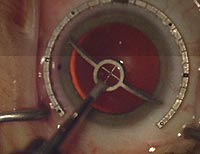 Nichamin fixation ring and gauge showing hash marks over central steep meridian, and two-cut ray marker delineating extent of arc to be incised. |
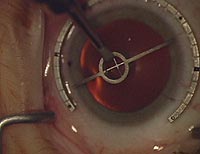 Opposite margin of incision marked. |
 Adjustable micrometer set on diamond blade at 90% of pachymetry measurement. |
 Inferior LRI begun, in peripheral most extent of clear corneal tissue. |
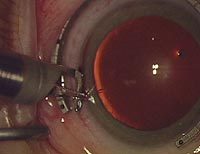 Inferior arc completed. |
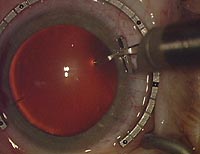 Superior LRI begun. | 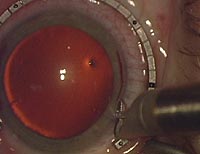 Superior LRI completed. |
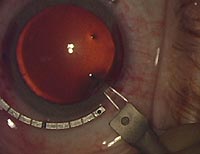 Side-port incision placed outside of LRI. | 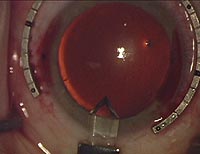 Temporal, single-plane clear corneal phaco wound completed. Images: Nichamin LD |
Moreover, an LRI is more forgiving than an astigmatic keratotomy incision, which is made in a smaller optical zone, Dr. Nichamin said.
“The smaller diameter zone, the more precise one has to be. As you move out peripherally, the relaxing incisions do need to become longer,” he said. “But they also become more forgiving.”
In addition, LRIs are not truly limbal. Rather, they are intralimbal incisions at the periphery of the clear cornea, Dr. Nichamin said.
An LRI should be clean, deep and perpendicular to the corneal surface, not beveled or angled.
“A beveled incision is oblique to the corneal surface. It’s not perpendicular. Oblique incisions lead to inconsistent results that are prone to regression. In addition, we want the incisions to be of adequate depth,” Dr. Nichamin said. Use of a modern nomogram with patient age and pachymetry is important to ensure the highest level of accuracy.
“Contrary to common belief, LRIs rarely lead to problems associated with corneal nerve damage such as excessive dry eye,” Dr. Nichamin said.
“There really is a wide safety margin with LRIs,” he said. “Some of the toric IOL advocates today are talking about problems with dry eye and de-enervation. I do appreciate these concerns, but after many years of use, I just have not seen this type of problem with any regularity.”
Minimizing residual cylinder
Correction by LRI, toric IOL or excimer laser is indicated for more than 0.5 D of astigmatism, Dr. Nichamin said.
“Most patients are good candidates,” he said. Contraindications for LRIs include irregular astigmatism, keratoconus, limbal disease or previous RK.
“In those cases, I do prefer a toric or, in really high cylinder, I combine both a toric and an LRI,” he said. “That’s a great marriage because those patients are so happy with the reduction of their onerous astigmatic refractive error.”
In Dr. Nichamin’s practice, one out of three cataract patients and about one out of two premium IOL patients undergo LRIs.
Rising expectations are leading clinicians to raise the bar for astigmatic outcomes, he said.
“Patients’ expectations are higher and the surgeons’ levels of results are more finite today. At one point, we were tolerating 1 D of residual cylinder, then it got down to 0.75 D, and now we’re down to 0.5 D. So as we raise that bar, more and more patients are being treated with these ancillary refractive techniques,” Dr. Nichamin said, adding that he combines toric IOLs and LRIs typically in patients with more than 3 D of astigmatism. – by Matt Hasson

- Louis D. ”Skip” Nichamin, MD, can be reached at Laurel Eye Clinic, 50 Waterford Pike, Brookville, PA 15825; 814-849-8344; fax: 814-849-7130; e-mail: nichamin@laureleye.com.
